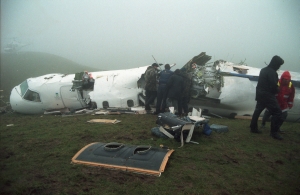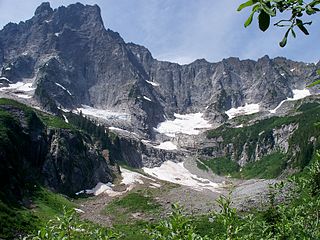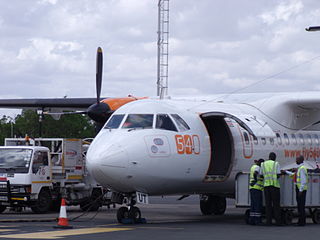
Kam Air Flight 904 was a scheduled passenger domestic flight, flying from Herat Airfield in Herat to Kabul International Airport in Afghanistan's capital of Kabul. On February 3, 2005, the aircraft impacted mountainous terrain, killing all 96 passengers and 8 crew on board.

United Airlines Flight 409 was a scheduled flight which originated in New York, New York. The final flight destination was San Francisco, California, with stops in Chicago, Denver and Salt Lake City. The aircraft operating the service, a Douglas DC-4 propliner, registration N30062, crashed into Medicine Bow Peak, near Laramie, Wyoming, on October 6, 1955, killing all 66 people on board. The victims included five female members of the Mormon Tabernacle Choir and military personnel. At the time, this was the deadliest airline crash in the history of American commercial aviation. Another 66 lives had been lost earlier that year in the March 22 crash in Hawaii of a United States Navy Douglas R6D-1 Liftmaster military transport aircraft, and 66 had also died in the mid-air collision of two United States Air Force C-119G Flying Boxcars over West Germany on August 11, placing the three crashes in a three-way tie as the deadliest aviation incidents in 1955.

Ansett New Zealand Flight 703 was an Ansett New Zealand scheduled passenger transport flight from Auckland Airport to Palmerston North. On 9 June 1995, the de Havilland Canada Dash 8 aircraft flying this route crashed into hilly terrain in the Tararua Ranges, 16 km east of Palmerston North airport, during an instrument approach in bad weather. The aircraft was carrying 18 passengers and three crew members. All passengers were New Zealand citizens except for one United States citizen. The flight attendant and three passengers died as a result of the crash.
The Edmonton Eskimos faced the Montreal Alouettes in the Grey Cup game for the third consecutive year. And for the third consecutive year, the Edmonton Eskimos were Grey Cup champions. It was the first time in a Grey Cup that a touchdown was worth six points instead of five.

Slesse Mountain, usually referred to as Mount Slesse, is a mountain just north of the US-Canada border, in the Cascade Mountains of British Columbia, near the town of Chilliwack. It is notable for its large, steep local relief. For example, its west face drops over 1,950 m (6,398 ft) to Slesse Creek in less than 3 km (2 mi). It is also famous for its huge Northeast Buttress; see the climbing notes below. The name means "fang" in the Halkomelem language. Notable nearby mountains include Mount Rexford and Canadian Border Peak in British Columbia, and American Border Peak, Mount Shuksan, and Mount Baker, all in the US state of Washington.

Calvin Jack Jones was a college football player for the University of Iowa. Jones is one of only two Iowa football players to have his jersey number retired by the school. Jones became the first Hawkeye, and the first African-American, to win the Outland Trophy in 1955. He played one year with the Winnipeg Blue Bombers of the Western Interprovincial Football Union. He died in a plane crash after playing in the East–West All-Star Game.

Asiana Airlines Flight 733 was a domestic Asiana Airlines passenger flight from Seoul-Gimpo International Airport to Mokpo Airport (MPK), South Korea. The Boeing 737 crashed on July 26, 1993, in the Hwawon area of Haenam County, South Jeolla Province. The cause of the accident was determined to be pilot error leading to controlled flight into terrain. 68 of the 116 passengers and crew on board were killed.

All Nippon Airways (ANA) Flight 60 was a Boeing 727-81 aircraft making a domestic commercial flight from Sapporo Chitose Airport to Tokyo Haneda International Airport. On February 4, 1966, all 133 people on board died when the plane mysteriously crashed into Tokyo Bay about 10.4 km from Haneda in clear weather conditions while on a night approach. The accident was the worst involving a single aircraft up to that time.

Santa Bárbara Airlines Flight 518 was an ATR 42–300 twin-turboprop aircraft, registration YV1449, operating as a scheduled domestic flight from Mérida, Venezuela, to Caracas that crashed into the side of a mountain on 21 February 2008, shortly after take-off. There were 43 passengers on board, with a crew consisting of two pilots and a flight attendant. The wreckage was discovered a day later with no survivors. It was the deadliest aviation accident involving an ATR 42 until Trigana Air Flight 267 crashed in Papua, Indonesia, in 2015 with 54 deaths.
Edwin Charles Harrison is a gridiron football guard who is currently a free agent. He recently played for the Calgary Stampeders of the Canadian Football League. He was signed by the Kansas City Chiefs as an undrafted free agent in 2008. He played college football at Colorado.
Melvin Howard "Mel" Becket, was an American college football and professional Canadian football player, and was one of 62 people who died on Trans-Canada Air Lines Flight 810, on December 9, 1956.
Mario Joseph DeMarco, was an American college football, National Football League, and professional Canadian football player, and was one of 62 people who died on Trans-Canada Air Lines Flight 810, on December 9, 1956.
Gordon Henry Sturtridge was a professional Canadian football player, and was one of 62 people who died on Trans-Canada Air Lines Flight 810, on December 9, 1956.
Raymond Nicholas "Ray" Syrnyk, was a professional Canadian football player, and was one of 62 people who died on Trans-Canada Air Lines Flight 810.

On 9 May 2012, a Sukhoi Superjet 100 airliner on a demonstration tour in Indonesia crashed into Mount Salak, in the province of West Java. All 37 passengers and 8 crew on board were killed. The plane had taken off minutes before from Jakarta's Halim Airport on a promotional flight for the recently launched jet, and was carrying Sukhoi personnel and representatives of various local airlines.

The Tachikawa air disaster occurred on the afternoon of Thursday, June 18, 1953 when a United States Air Force (USAF) Douglas C-124 Globemaster II aircraft crashed three minutes after takeoff from Tachikawa, Japan, killing all 129 people on board. At the time, the crash was tied for the deadliest in aviation history, and is notable for being the second aviation accident to kill more than 100 people; the crash of a Luftwaffe Me-321 Gigant glider and its three Bf-110 tow planes during operational trials in 1941 is claimed to have resulted in 129 fatalities.

Pan Am Flight 923 was a Douglas DC-4 operating from Seattle, Washington to Juneau, Alaska, which crashed into Tamgas Mountain on Annette Island, Alaska, on October 26, 1947. All 18 passengers and crew on board were killed.

West Wind Aviation Flight 280 was a domestic passenger flight from Fond-du-Lac Airport to Stony Rapids Airport, Canada. The aircraft was an ATR 42-320 registered C-GWEA. On 13 December 2017, shortly after taking off from Fond-du-Lac, the ATR-42 lost altitude and hit the ground. All 25 passengers and crew initially survived the crash, but one passenger later died of his injuries in hospital. Investigation on the cause of the crash is still ongoing.















